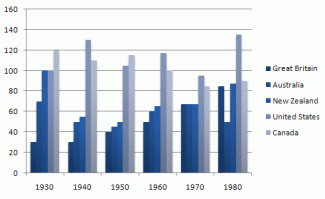The table below shows the figures (in thousand) for imprisonment in five countries between 1930 and 1980.

The bar chart gives information about how the imprisonment statistics changed in five different countries from 1930 to 1980.
Overall, it is evident that the number of prisoners in Great Britain increased significantly during these period while these figures for other countries fluctuated.
In 1930, Great Britain had the fewest number of prisoners, at 30.000 whereas Canada had the higest figure of offenders, at 120.000. These figures for New Zealand and United Nation were exactly the same, at 100.000 which was higher than the figure of Australia (only 70.000). In the following years, Great Britain witnessed a consistent increase in the number of prisoners and this figure reached a peak of more than 80.000 in 1980. Whereas, the figures for other countries saw fluctuations. For example, the number of criminals in Australia decreased from 70.000 to 40.000 in 1950 an then rose up again in the next 30 years. In Canada, the number of prisoners reached a peak of 130.000 in 1940 and then fluctuated while this figure for United Nation fluctuated during the observed time.
At the end of the period, in 1980, United Nation was the nation having the highest number of criminals, at approximately 140.000, followed by Canada, New Zealand and Great Britain, where had around 80.000 offenders each. The number of prisoners in Australia was only 50.000 which was the lowest among all countries.

Grammar and spelling errors:
Line 3, column 501, Rule ID: WHITESPACE_RULE
Message: Possible typo: you repeated a whitespace
Suggestion:
...countries saw fluctuations. For example, the number of criminals in Australia dec...
^^
Line 3, column 580, Rule ID: EN_A_VS_AN
Message: Use 'a' instead of 'an' if the following word doesn't start with a vowel sound, e.g. 'a sentence', 'a university'
Suggestion: a
...decreased from 70.000 to 40.000 in 1950 an then rose up again in the next 30 years...
^^
Line 3, column 580, Rule ID: AN_THEN[1]
Message: Possible typo. Did you mean 'and then'?
Suggestion: and then
...decreased from 70.000 to 40.000 in 1950 an then rose up again in the next 30 years. In ...
^^^^^^^
Transition Words or Phrases used:
if, so, then, whereas, while, for example
Attributes: Values AverageValues Percentages(Values/AverageValues)% => Comments
Performance on Part of Speech:
To be verbs : 6.0 7.0 86% => OK
Auxiliary verbs: 0.0 1.00243902439 0% => OK
Conjunction : 4.0 6.8 59% => More conjunction wanted.
Relative clauses : 4.0 3.15609756098 127% => OK
Pronoun: 7.0 5.60731707317 125% => Less pronouns wanted
Preposition: 41.0 33.7804878049 121% => OK
Nominalization: 2.0 3.97073170732 50% => More nominalizations (nouns with a suffix like: tion ment ence ance) wanted.
Performance on vocabulary words:
No of characters: 1169.0 965.302439024 121% => OK
No of words: 228.0 196.424390244 116% => OK
Chars per words: 5.12719298246 4.92477711251 104% => OK
Fourth root words length: 3.88582923847 3.73543355544 104% => OK
Word Length SD: 2.62133605997 2.65546596893 99% => OK
Unique words: 120.0 106.607317073 113% => OK
Unique words percentage: 0.526315789474 0.547539520022 96% => OK
syllable_count: 330.3 283.868780488 116% => OK
avg_syllables_per_word: 1.4 1.45097560976 96% => OK
A sentence (or a clause, phrase) starts by:
Pronoun: 2.0 1.53170731707 131% => OK
Interrogative: 1.0 0.114634146341 872% => Less interrogative sentences wanted.
Article: 5.0 4.33902439024 115% => OK
Subordination: 0.0 1.07073170732 0% => More adverbial clause wanted.
Conjunction: 0.0 0.482926829268 0% => OK
Preposition: 9.0 3.36585365854 267% => Less preposition wanted as sentence beginnings.
Performance on sentences:
How many sentences: 10.0 8.94146341463 112% => OK
Sentence length: 22.0 22.4926829268 98% => OK
Sentence length SD: 41.0531362992 43.030603864 95% => OK
Chars per sentence: 116.9 112.824112599 104% => OK
Words per sentence: 22.8 22.9334400587 99% => OK
Discourse Markers: 4.1 5.23603664747 78% => OK
Paragraphs: 4.0 3.83414634146 104% => OK
Language errors: 3.0 1.69756097561 177% => OK
Sentences with positive sentiment : 5.0 3.70975609756 135% => OK
Sentences with negative sentiment : 3.0 1.13902439024 263% => Less negative sentences wanted.
Sentences with neutral sentiment: 2.0 4.09268292683 49% => OK
What are sentences with positive/Negative/neutral sentiment?
Coherence and Cohesion:
Essay topic to essay body coherence: 0.168292594261 0.215688989381 78% => OK
Sentence topic coherence: 0.0894486437942 0.103423049105 86% => OK
Sentence topic coherence SD: 0.0704047546606 0.0843802449381 83% => OK
Paragraph topic coherence: 0.125172469674 0.15604864568 80% => OK
Paragraph topic coherence SD: 0.0759005274964 0.0819641961636 93% => OK
Essay readability:
automated_readability_index: 14.1 13.2329268293 107% => OK
flesch_reading_ease: 66.07 61.2550243902 108% => OK
smog_index: 3.1 6.51609756098 48% => Smog_index is low.
flesch_kincaid_grade: 9.5 10.3012195122 92% => OK
coleman_liau_index: 12.77 11.4140731707 112% => OK
dale_chall_readability_score: 8.05 8.06136585366 100% => OK
difficult_words: 48.0 40.7170731707 118% => OK
linsear_write_formula: 10.5 11.4329268293 92% => OK
gunning_fog: 10.8 10.9970731707 98% => OK
text_standard: 11.0 11.0658536585 99% => OK
What are above readability scores?
---------------------
Rates: 73.0337078652 out of 100
Scores by essay e-grader: 6.5 Out of 9
---------------------
Note: the e-grader does NOT examine the meaning of words and ideas. VIP users will receive further evaluations by advanced module of e-grader and human graders.